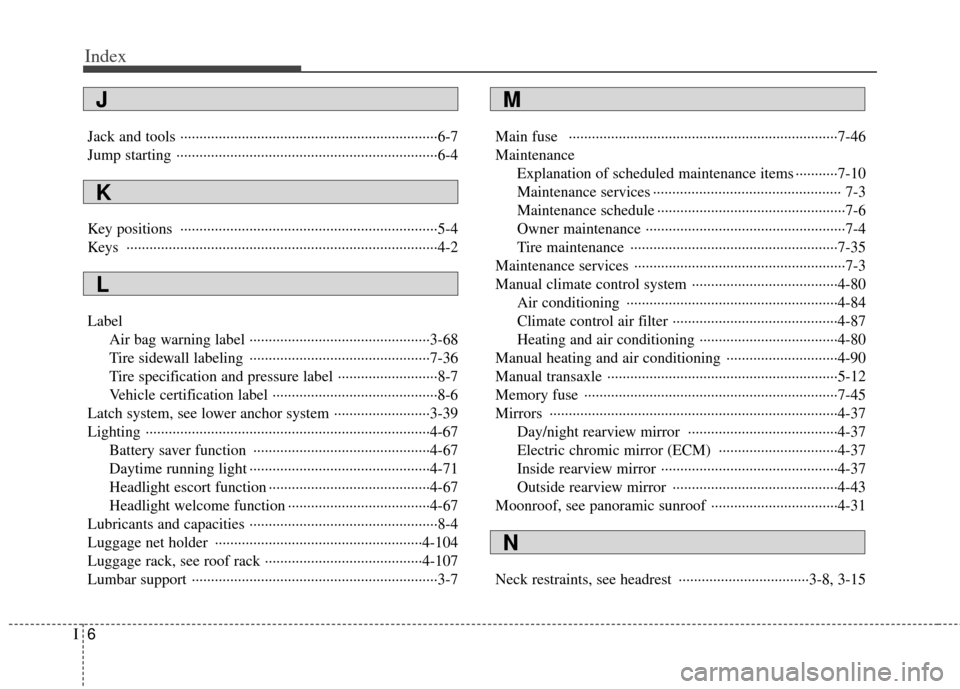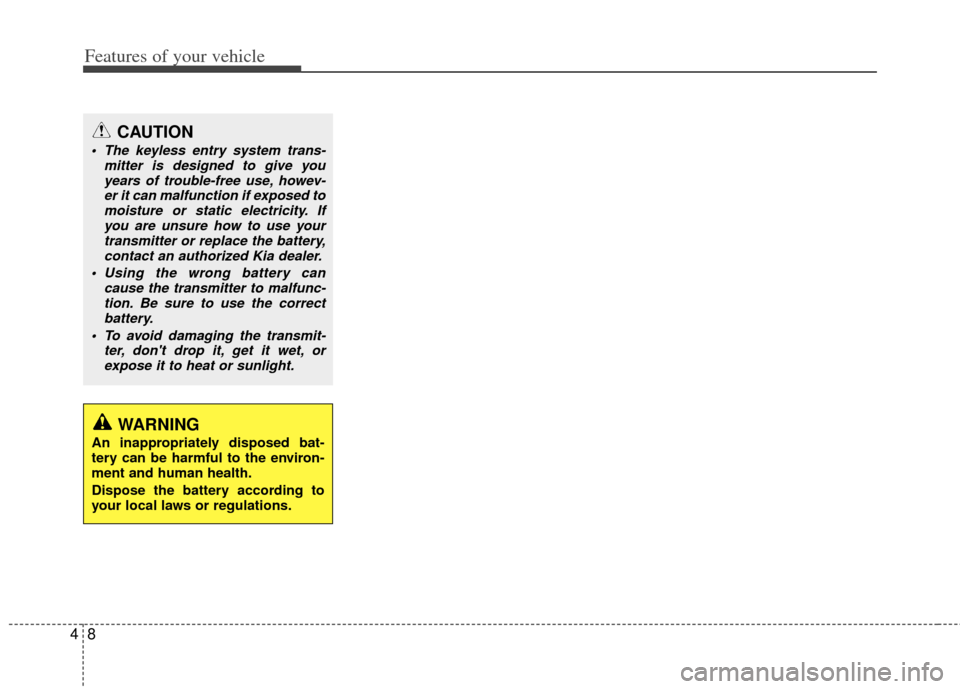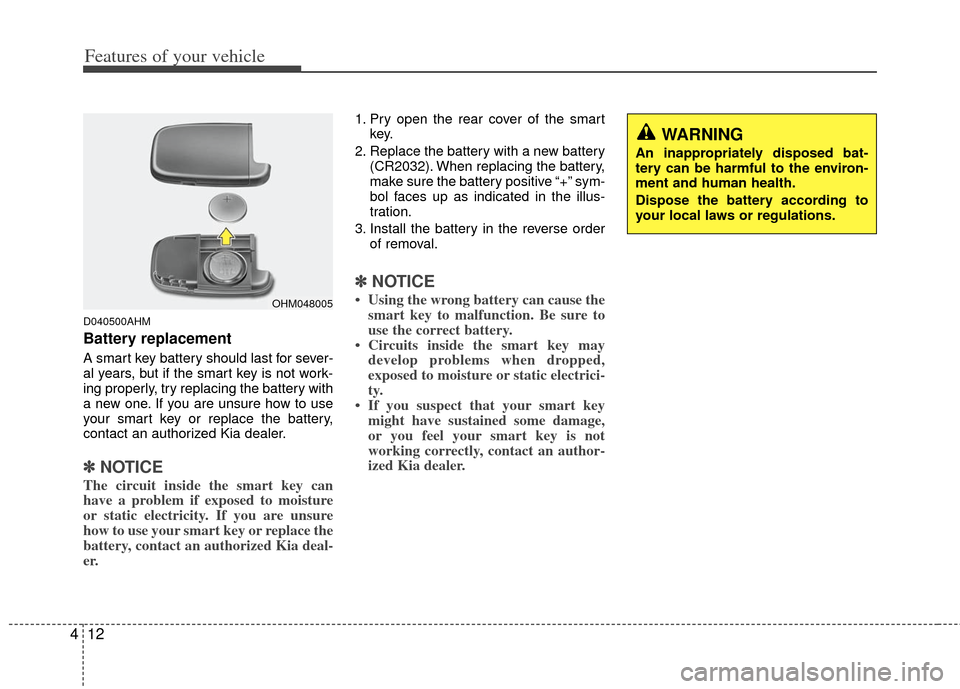2013 KIA Sportage battery
[x] Cancel search: batteryPage 5 of 387

Index
2I
Air bags ··················\
··················\
··················\
··················\
···3-42Air bag warning label................................................3-68
Air bag warning light ................................................3-45
Curtain air bag ..........................................................3-60
Driver's and passenger's front air bag ......................3-54
Side impact air bag....................................................3-58
Air cleaner··················\
··················\
··················\
·················7-23\
Alarm system ··················\
··················\
··················\
············4-13
All wheel drive (AWD), see four wheel drive (4WD) ··················\
··················\
··················\
···········5-21
Antenna ··················\
··················\
··················\
··················\
·4-108
Anti-lock brake system (ABS)··················\
··················\
····5-30
Appearance care··················\
··················\
··················\
········7-53 Exterior care ··················\
··················\
··················\
········7-53
Interior care ··················\
··················\
··················\
·········7-58
Armrest ··················\
··················\
··················\
··················\
···3-16
Audio system ··················\
··················\
··················\
··········4-108 Antenna ··················\
··················\
··················\
·············4-108
Aux, USB and iPod ··················\
··················\
·············4-110
Steering wheel audio control ··················\
················4-109
Automatic climate control system ··················\
················4-88 Air conditioning ··················\
··················\
··················\
··4-94
Automatic heating and air conditioning··················\
··4-89
Manual heating and air conditioning ··················\
······4-90 Automatic transaxle ··················\
··················\
··················\
··5-15
Ignition key interlock system ··················\
··················\
5-19
Shift lock system ··················\
··················\
··················\
·5-18
Sports mode··················\
··················\
··················\
·········5-17
Battery ··················\
··················\
··················\
··················\
·····7-28
Battery saver function ··················\
··················\
·················4-67\
Before driving ··················\
··················\
··················\
·············5-3
Bottle holders, see cup holders ··················\
··················\
·4-101
Brake fluid ··················\
··················\
··················\
················7-21
Brake system ··················\
··················\
··················\
·············5-27 Anti-lock brake system (ABS) ··················\
················5-30
Downhill brake control (DBC)··············\
··················\
··5-36
Electronic stability control (ESC) ··················\
···········5-32
Parking brake··················\
··················\
··················\
·······5-28
Power brakes ··················\
··················\
··················\
·······5-27
Bulb wattage ··················\
··················\
··················\
···············8-2
Button start/stop, see engine start/stop button ··················\
5-7
Capacities (Lubricants) ··················\
··················\
·················8-4
Care Exterior care ··················\
··················\
··················\
········7-53
Interior care ··················\
··················\
··················\
·········7-58
Tire care··················\
··················\
··················\
···············7-31
A
B
C
Page 9 of 387

Index
6I
Jack and tools ··················\
··················\
··················\
·············6-7
Jump starting ··················\
··················\
··················\
··············6-4
Key positions ··················\
··················\
··················\
·············5-4
Keys ··················\
··················\
··················\
··················\
·········4-2
LabelAir bag warning label ··················\
··················\
···········3-68
Tire sidewall labeling ··················\
··················\
···········7-36
Tire specification and pressure label ··················\
········8-7
Vehicle certification label ··················\
··················\
·······8-6
Latch system, see lower anchor system ··················\
·······3-39
Lighting ················\
··················\
··················\
··················\
····4-67 Battery saver function ··················\
··················\
··········4-67
Daytime running light ··················\
··················\
···········4-71
Headlight escort function ··················\
··················\
······4-67
Headlight welcome function ··················\
··················\
·4-67
Lubricants and capacities ··················\
··················\
·············8-4
Luggage net holder ··················\
··················\
··················\
4-104
Luggage rack, see roof rack ··················\
··················\
·····4-107
Lumbar support ··················\
··················\
··················\
··········3-7 Main fuse ··················\
··················\
··················\
················7-46
Maintenance
Explanation of scheduled maintenance items ···········7-10Maintenance services ··················\
··················\
············· 7-3
Maintenance schedule ··················\
··················\
·············7-6
Owner maintenance ··················\
··················\
················7-4
Tire maintenance ··················\
··················\
··················\
7-35
Maintenance services ··················\
··················\
··················\
·7-3
Manual climate control system ··················\
··················\
··4-80 Air conditioning ··················\
··················\
··················\
·4-84
Climate control air filter ··················\
··················\
·······4-87
Heating and air conditioning ··················\
··················\
4-80
Manual heating and air conditioning ··················\
···········4-90
Manual transaxle ··················\
··················\
··················\
······5-12
Memory fuse ··················\
··················\
··················\
············7-45
Mirrors ················\
··················\
··················\
··················\
·····4-37 Day/night rearview mirror ··················\
··················\
···4-37
Electric chromic mirror (ECM) ··················\
·············4-37
Inside rearview mirror ··················\
··················\
··········4-37
Outside rearview mirror ··················\
··················\
·······4-43
Moonroof, see panoramic sunroof ··················\
···············4-31
Neck restraints, see headrest ··················\
················3-8, 3-15
L
M
N
K
J
Page 22 of 387

Your vehicle at a glance
42
ENGINE COMPARTMENT
B030000AUN-C1
1. Engine coolant reservoir ..................7-18
2. Engine oil filler cap ..........................7-16
3. Brake/clutch* fluid reservoir ............7-21
4. Positive battery terminal ..................7-28
5. Negative battery terminal ................7-28
6. Fuse box ..........................................7-45
7. Air cleaner ........................................7-23
8. Engine oil dipstick ............................7-16
9. Radiator cap ....................................7-20
10. Windshield washer fluid reservoir ..7-22
* if equipped
OLM079001/OSL071001N
❈The actual engine room in the vehicle may differ from the illustration.
■
■
MPI engine
■
■ T-GDI engine
Page 40 of 387

Safety features of your vehicle
18
3
SEAT BELTS
C020100AHM
Seat belt restraint system
WARNING
For maximum restraint system
protection, the seat belts must
always be used whenever the
vehicle is moving.
Seat belts are most effective when seatbacks are in the
upright position.
Children age 12 and under must always be properly restrained in
the rear seat. Never allow chil-
dren to ride in the front passen-
ger seat. If a child over 12 must
be seated in the front seat, he/she
must be properly belted and the
seat should be moved as far back
as possible.
Never wear the shoulder belt under your arm or behind your
back. An improperly positioned
shoulder belt can cause serious
injuries in a crash. The shoulder
belt should be positioned midway
over your shoulder across your
collarbone.
(Continued)
(Continued)
Avoid wearing twisted seat belts.A twisted belt can't do its job
well. In a collision, it could even
cut into you. Be sure the belt
webbing is straight and not twist-
ed.
Be careful not to damage the belt webbing or hardware. If the belt
webbing or hardware is dam-
aged, replace it.(Continued)
Care should be taken to avoid con-
tamination of the webbing with pol-
ishes, oils and chemicals, and par-
ticularly battery acid. Cleaning may
safely be carried out using mild
soap and water. The belt should be
replaced if webbing becomes
frayed, contaminated or damaged.
It is essential to replace the entire
assembly after it has been worn in
a severe impact even if damage to
the assembly is not obvious. Belts
should not be worn with straps
twisted. Each belt assembly must
only be used by one occupant; it is
dangerous to put a belt around a
child being carried on the occu-
pant's lap.
WARNING
Seat belts are designed to bear
upon the bony structure of the
body, and should be worn low
across the front of the pelvis or the
pelvis, chest and shoulders, as
applicable; wearing the lap section
of the belt across the abdominal
area must be avoided.
Seat belts should be adjusted as
firmly as possible, consistent with
comfort, to provide the protection
for which they have been designed.
A slack belt will greatly reduce the
protection afforded to the wearer.
(Continued)
Page 70 of 387

Safety features of your vehicle
48
3
C040300AAM
Occupant Detection System
(ODS)
Your vehicle is equipped with an occu-
pant detection system in the front pas-
senger's seat.
The occupant detection system is
designed to detect the presence of a
properly-seated front passenger and
determine if the passenger's front air bag
should be enabled (may inflate) or not.
The driver's front air bag is not affected
or controlled by the occupant detection
system.
WARNING
If an air bag deploys, there may
be a loud noise followed by a fine
dust released in the vehicle.
These conditions are normal and
are non-toxic - the air bags are
packed in this fine powder. The
dust generated during air bag
deployment may cause skin or
eye irritation as well as aggravate
asthma for some persons.
Always wash all exposed skin
areas thoroughly with lukewarm
water and a mild soap after an
accident in which the air bags
were deployed.
The SRS can function only when the ignition switch is in the ON
position. If the SRS air bag warn-
ing light does not illuminate, or
continuously remains on after
illuminating for about 6 seconds
when the ignition switch is turned
to the ON position, or after the
engine is started, comes on while
driving, the SRS is not working
properly. If this occurs, have your
vehicle immediately inspected by
an authorized Kia dealer.
(Continued)
(Continued)
Before you replace a fuse or dis-connect a battery terminal, turn
the ignition switch to the LOCK
position and remove the ignition
switch. Never remove or replace
the air bag related fuse(s) when
the ignition switch is in the ON
position. Failure to heed this
warning will cause the SRS air
bag warning light to illuminate.
WARNING
Do not put anything in front of the
passenger air bag indicator.
OSL030055N
Page 97 of 387

47
Features of your vehicle
D020200AAM-EU
Transmitter precautions
✽
✽NOTICE
The transmitter will not work if any of
the following occurs:
• The ignition key is in the ignition
switch.
• You exceed the operating distance limit (10 m [about 30 feet]).
• The battery in the transmitter is weak.
• Other vehicles or objects may be blocking the signal.
• The weather is extremely cold.
• The transmitter is close to a radio transmitter such as a radio station or
an airport which can interfere with
normal operation of the transmitter.
When the transmitter does not work
properly, open and close the door with
the ignition key. If you have a problem
with the transmitter, contact an author-
ized Kia dealer.
This device complies with Industry
Canada Standard RSS-210.
Operation is subject to the following two
conditions:
1. This device may not cause harmful
interference, and
2. This device must accept any interfer- ence received, including interference
that may cause undesired operation.
D020300AHM
Battery replacement
A transmitter uses a 3 volt lithium battery
which will normally last for several years.
When replacement is necessary, use the
following procedure.
1. Insert a slim tool into the slot and gen-tly pry open the transmitter center
cover.
2. Replace the battery with a new battery (CR2032). When replacing the battery,
make sure the battery positive “+” sym-
bol faces up as indicated in the illus-
tration.
3. Install the battery in the reverse order of removal.
For transmitter replacement, see an
authorized Kia dealer to reprogram the
transmitter.
CAUTION
Changes or modifications not expressly approved by the party responsible for compliance couldvoid the user’s authority to operatethe equipment. If the keyless entry system is inoperative due tochanges or modifications not expressly approved by the partyresponsible for compliance, it willnot be covered by your manufactur- er’s vehicle warranty.
CAUTION
Keep the transmitter away fromwater or any liquid. If the keylessentry system is inoperative due toexposure to water or liquids, it willnot be covered by your manufactur- er’s vehicle warranty.
OED039003A
Page 98 of 387

Features of your vehicle
84
CAUTION
The keyless entry system trans-mitter is designed to give youyears of trouble-free use, howev-er it can malfunction if exposed tomoisture or static electricity. If you are unsure how to use yourtransmitter or replace the battery,contact an authorized Kia dealer.
Using the wrong battery can cause the transmitter to malfunc-tion. Be sure to use the correctbattery.
To avoid damaging the transmit- ter, don't drop it, get it wet, orexpose it to heat or sunlight.
WARNING
An inappropriately disposed bat-
tery can be harmful to the environ-
ment and human health.
Dispose the battery according to
your local laws or regulations.
Page 102 of 387

Features of your vehicle
12
4
D040500AHM
Battery replacement
A smart key battery should last for sever-
al years, but if the smart key is not work-
ing properly, try replacing the battery with
a new one. If you are unsure how to use
your smart key or replace the battery,
contact an authorized Kia dealer.
✽ ✽
NOTICE
The circuit inside the smart key can
have a problem if exposed to moisture
or static electricity. If you are unsure
how to use your smart key or replace the
battery, contact an authorized Kia deal-
er.
1. Pry open the rear cover of the smart
key.
2. Replace the battery with a new battery (CR2032). When replacing the battery,
make sure the battery positive “+” sym-
bol faces up as indicated in the illus-
tration.
3. Install the battery in the reverse order of removal.
✽ ✽NOTICE
• Using the wrong battery can cause the
smart key to malfunction. Be sure to
use the correct battery.
• Circuits inside the smart key may develop problems when dropped,
exposed to moisture or static electrici-
ty.
• If you suspect that your smart key might have sustained some damage,
or you feel your smart key is not
working correctly, contact an author-
ized Kia dealer.OHM048005
WARNING
An inappropriately disposed bat-
tery can be harmful to the environ-
ment and human health.
Dispose the battery according to
your local laws or regulations.